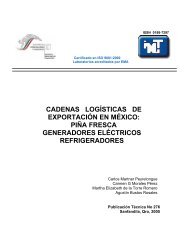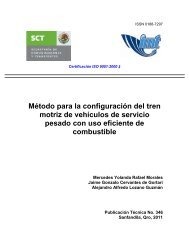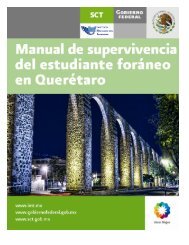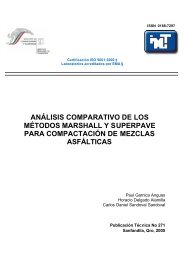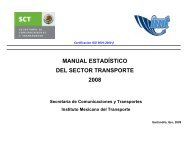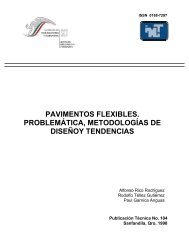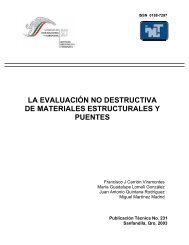IngenierÃa de Caminos Rurales - Instituto Mexicano del Transporte
IngenierÃa de Caminos Rurales - Instituto Mexicano del Transporte
IngenierÃa de Caminos Rurales - Instituto Mexicano del Transporte
You also want an ePaper? Increase the reach of your titles
YUMPU automatically turns print PDFs into web optimized ePapers that Google loves.
Tabla 6.1<br />
CLASIFICACIÓN Y GRANULOMETRÍA DEL ENROCAMIENTO DE<br />
PROTECCIÓN<br />
(en peso y tamaño <strong>de</strong> los fragmentos <strong>de</strong> roca)<br />
Porcentaje que pasa<br />
(Porcentaje <strong>de</strong>l enrocamiento<br />
Categoría Peso Tamaño <strong>de</strong> la roca* menor que el tamaño indicado)<br />
Kilogramos<br />
(libras)<br />
Centímetros<br />
Clase I 5 (11) 15 100<br />
2,5 (5) 12 80<br />
0,5 (1) 7 50<br />
0,1 (0,2) 3 10 máximo<br />
Clase II 25 (55) 25 100<br />
15 (35) 20 80<br />
5 (11) 15 50<br />
0,5 (1) 8 10 máximo<br />
Clase III 50 (100) 30 100<br />
30 (60) 25 80<br />
10 (25) 20 50<br />
1 (2) 10 10 máximo<br />
Clase V 100 (220) 45 100<br />
70 (150) 35 70<br />
35 (75) 25 30<br />
7 (15) 15 10 máximo<br />
Clase VII 300 (650) 60 100<br />
200 (440) 50 70<br />
100 (220) 40 30<br />
10 (22) 20 10 máximo<br />
Clase VIII 1 000 (2 200) 90 100<br />
600 (1 320) 70 70<br />
200 (440) 50 30<br />
30 (65) 25 10 máximo<br />
Clase X 2 000 (4 400) 120 100<br />
1 000 (2 200) 90 80<br />
300 (660) 60 50<br />
40 (90) 30 10 máximo<br />
Fuente: Adaptado <strong>de</strong> USDA-Forest Service.<br />
*diámetro esférico equivalente<br />
entre el suelo <strong>de</strong> la margen <strong>de</strong> un arroyo<br />
y la capa <strong>de</strong> enrocamiento <strong>de</strong><br />
protección.<br />
Empleo <strong>de</strong> geotextiles<br />
Los geotextiles tejidos o no tejidos<br />
punzados con aguja se usan<br />
generalmente para lograr un filtro entre<br />
la roca y el suelo, con lo cual se<br />
evita la socavación y el movimiento<br />
INGENIERÍA DE CAMINOS RURALES: 48<br />
<strong>de</strong>l suelo. Son relativamente fáciles<br />
<strong>de</strong> instalar bajo la mayoría <strong>de</strong> las<br />
condiciones, jalando la tela hasta que<br />
que<strong>de</strong> estirada sobre el área <strong>de</strong>l suelo<br />
que se va a proteger antes <strong>de</strong><br />
proce<strong>de</strong>r a colocar el enrocamiento<br />
(Foto 6.5). Se pue<strong>de</strong> usar un geotextil<br />
tejido <strong>de</strong> un solo filamento o uno <strong>de</strong>l<br />
tipo no tejido y punzado con aguja, y<br />
a<strong>de</strong>más <strong>de</strong>be ser permeable. Es<br />
necesario que el geotextil tenga un<br />
Tamaño Aparente <strong>de</strong> Abertura <strong>de</strong> entre<br />
0,25 y 0,5 mm. A falta <strong>de</strong> mayor<br />
información, se usa comúnmente un<br />
geotextil no tejido punzado con aguja<br />
con peso <strong>de</strong> 200 g/m 2 (6,0 oz/yd 2 )<br />
para muchas aplicaciones <strong>de</strong> filtración<br />
y separación <strong>de</strong> suelos.<br />
Entre otras aplicaciones comunes<br />
<strong>de</strong> geotextiles o <strong>de</strong> materiales



